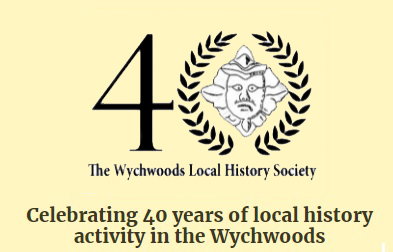The Initial Vision | 1981: The First Meetings of the Society | 1984/5: Meeting Patterns Established – First Publications | The 1990s: Highlights of the Decade | The New Millennium| Looking Ahead – Members’ Survey | Towards Digitalisation | Embracing Technology – Photograph Archive Scanning | 2016/18: Website Re-launched | The 2020s: Moving Forward
1981: The First Meetings of the Society
At the first meeting on 22 September 1981 the chairman, Geoffrey Giles, spoke on ‘Tracing your Family History’, and in January, Tom Barrett from Milton spoke on ‘The Story of Shipton Gasworks’. These were followed by ‘Recording Oral History’ and ‘Vernacular Buildings’.
(follow this link for details of all annual programmes 1981-2021)
The Society’s Aims and Ambitions
It is worth recalling the original aims of the Society: ‘To foster interest in the local history of the area, to preserve past records, to carry out local surveys, to record all the work carried out and to place copies of such records in the archives of the Society and of suitable libraries’.
Several projects were recognised from the outset as being of high priority: a record of gravestones in Milton; a record of field names; a hedge species count; the compilation of a map of all historical and interesting sites; tape recordings of elderly folks’ memories and dialects and as complete a photographic record as possible of buildings and sites.
This was quite an ambitious programme to contemplate and overestimated the number of members who would be prepared to be actively involved. There were therefore a few false starts, but a lot of good work was done from the beginning.
Early Activities: Hedge-Counting and Archive Development
Mike Linfield and Norman Frost concentrated on their photographic recording and Gwen Allen led a group of about twenty members on successful hedge-counting forays.
An early task was the indexing and transcription of Shipton Court estate papers loaned from the parish council. A group transcribed the 1851 census returns from villages in the ‘old’ parish, which included Shipton, Milton, Ascott, Leafield, Lyneham, Langley and Ramsden. (Since then, subsequent decades’ returns have been covered)
Neither the recording of village buildings nor the oral history project got off the ground in the early days.
1981/2: The First Newsletter, the First AGM, and Progress
The first newsletter published in autumn 1981 contained an appeal to members for old photographs, maps newspapers and items of historical interest. This first season saw 88 members and two editions of the newsletter.
After the first AGM in April 1982 the committee comprised Geoffrey Giles (chairman), Norman Frost (secretary) and Mr and Mrs H Smith, Jack and Joan Howard-Drake, Mike Linfield, Jack Chapman, Gwen Allen, Margaret and Frank Ware and Sue Jourdan.
Frank Ware took over the treasurership, Margaret Ware became membership secretary, with Sue Jourdan and Joan Howard-Drake undertaking temporary secretarial duties. Six meetings were arranged for the following year plus the AGM, with a fund-raising members’ evening planned for the following January with a few displays of the society’s activities.
Jack Howard-Drake took over production of the twice-yearly newsletter after the death of Rob Long. Under the auspices of the Family History Society the Howard-Drakes started transcribing Shipton parish registers from 1538-1899, the Giles Ascott and Leafield and the Ashtons Fifield, Idbury and Bould, a task which was to take several years.
1982/3: Archaeology and Fieldwalking
Meanwhile in the winter of 1982/83, several members attended a series of ‘Introduction to Archaeology’ evening classes given by Clare Halpin. Little did the participants realise, as they squeezed onto the tiny chairs in the Wychwood School, what a seminal moment this was to be in the history of the Society, as she described the hitherto unheard-of activity of fieldwalking.
1983: Fund-Raisers | First Exhibition | Growing Membership
In January 1983 we found that the fund-raising members’ evening with wine and a ploughman’s supper had grown to a substantial exhibition and well over a hundred enthusiastic people crowded into Milton Village Hall.
Among the visitors was Dr Kate Tiller of the Oxford University Department for External Studies (as it was then) who congratulated us and offered to hold a series of evening classes in the Wychwoods on ‘Sources of Local History’, which duly started the following winter.
In 1983 Mr and Mrs Smith left the committee due to ill health while the committee gained Tom Barrett and Sue Richards (as editor), with Jack Chapman became vice-chairman.
Membership stood at about a hundred. Audiences at meetings averaged nearly seventy at Milton, but only about forty at Shipton. This was thought in part to be due to the poor state of Shipton’s old hall and the difficulty of parking. Norman Frost was by this time corresponding with overseas members of the Groves family, among others, and the Society was beginning to get an increasing number of enquiries from people researching their families.
1984: Expanding Activities | The First Fieldwalk
Jack Howard-Drake succeeded Geoffrey Giles as chairman in 1984, and Rachel Grant joined the committee as meetings secretary. Norman Frost was busy compiling the Groves family tree and gave a series of classes to local girl guides who were taking their local history badge.
June 1984 saw the Society’s first summer field excursion when Frank Ware led a group round the common boundary of the Saxon Manors of Witney and Shipton.
In September, eleven members took part in the Society’s first fieldwalk. Elaborate preparations were made: we put up a tent, a stove and boiled a kettle for tea and Tom Barrett, a stalwart St John Ambulanceman, brought his first aid kit as if we were operating in the wilds of Africa instead of just down the Ascott Road!
Fieldwalks took place annually for many years afterwards, although preparations were greatly simplified!


